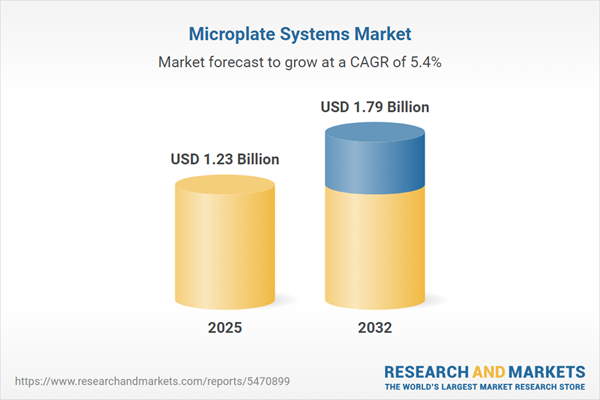Speak directly to the analyst to clarify any post sales queries you may have.
The microplate systems market is evolving rapidly as life sciences organizations seek scalable, efficient instrumentation to streamline research, discovery, and screening activities. Emerging innovations and resilient supply strategies are fundamentally reshaping the landscape for decision-makers aiming to strengthen operational competitiveness.
Market Snapshot: Microplate Systems Market Growth and Trends
The Microplate Systems Market grew from USD 1.17 billion in 2024 to USD 1.23 billion in 2025. It is expected to continue growing at a CAGR of 5.41%, reaching USD 1.79 billion by 2032. This growth reflects increasing demand for advanced instrumentation in biotechnology and pharmaceutical sectors, ongoing expansion of automated workflows, and the intensifying focus on data integrity and reproducibility. Widespread adoption in both established and emerging research hubs underscores the market’s broad relevance across academia, biotech, pharma, and contract research organizations.
Scope & Segmentation Overview
- Product Type: Plate Dispensers, Plate Readers, Plate Stackers, Plate Washers
- Detection Technology: Absorbance, Fluorescence, Luminescence
- End User: Academic and Research Institutes, Biotechnology Companies, Contract Research Organizations, Pharmaceutical Companies
- Well Format: 1536 Well, 384 Well, 96 Well
- Automation Level: Fully Automated Systems, Manual Systems, Semi Automated Systems
- Regions Covered: Americas (including North America and Latin America), Europe, Middle East & Africa, Asia-Pacific
- Key Companies Profiled: Thermo Fisher Scientific Inc., Danaher Corporation, Agilent Technologies, Inc., Becton, Dickinson and Company, Bio-Rad Laboratories, Inc., PerkinElmer, Inc., Tecan Group Ltd., Corning Incorporated, Molecular Devices, LLC, Merck KGaA
Key Takeaways for Senior Decision-Makers
- Expanding automation, digitalization, and modular upgrades are driving system replacement cycles and reinforcing scalability in research-intensive environments.
- Detection technology selection—whether absorbance, fluorescence, or luminescence—remains central for optimizing assay robustness, sensitivity, and operational throughput across diverse applications.
- Minimizing reagent consumption and maximizing parallel assay capabilities are enabled by adoption of high-density well formats and advanced miniaturization techniques.
- Laboratories requiring adaptable platforms increasingly favor integrated, software-driven solutions for protocol development, remote monitoring, and predictive analytics.
- Sustainability considerations and modular instrument architectures are aligning with industry priorities to reduce environmental impact and extend equipment life cycles.
- Service differentiation—such as local calibration and rapid support—is emerging as a key factor in vendor selection for both established and budget-conscious users.
Tariff Impact: Resilience in Supply Chains and Procurement
The 2025 United States tariffs have imposed substantial challenges on sourcing, pricing, and logistics for core microplate system components. Many manufacturers are diversifying supplier networks, investing in localized assembly, and emphasizing value-added services to mitigate increased import duties and potential production delays. End users are adjusting procurement models, favoring multi-functional platforms, longer-term supply agreements, and sometimes exploring pre-owned or refurbished instrumentation to manage capital expenditures and sustain operational flexibility.
Methodology & Data Sources
This market intelligence report leverages comprehensive secondary research alongside primary interviews with laboratory leaders, procurement experts, and R&D managers. Structured end-user surveys and supplier documentation were triangulated with patent reviews and peer validation to ensure data accuracy, contextual depth, and segmentation reliability.
Why This Report Matters
- Delivers actionable market segmentation and supplier intelligence spanning product types, detection modalities, user profiles, and automation levels in the microplate systems industry.
- Offers research-driven insights to support capital allocation, procurement rationalization, and strategic planning amid evolving global trade and innovation trends.
- Enables evidence-based decisions for technology adoption, lifecycle management, and competitive positioning across biotech, pharma, CROs, and research institutes.
Conclusion
Senior decision-makers can leverage this report to anticipate shifts in technology, supply chain strategies, and regulatory landscapes. A data-driven, segment-specific approach is key to maintaining performance, sustainability, and agility in the dynamic microplate systems market.
Additional Product Information:
- Purchase of this report includes 1 year online access with quarterly updates.
- This report can be updated on request. Please contact our Customer Experience team using the Ask a Question widget on our website.
Table of Contents
3. Executive Summary
4. Market Overview
7. Cumulative Impact of Artificial Intelligence 2025
Companies Mentioned
The companies profiled in this Microplate Systems market report include:- Thermo Fisher Scientific Inc.
- Danaher Corporation
- Agilent Technologies, Inc.
- Becton, Dickinson and Company
- Bio-Rad Laboratories, Inc.
- PerkinElmer, Inc.
- Tecan Group Ltd.
- Corning Incorporated
- Molecular Devices, LLC
- Merck KGaA
Table Information
| Report Attribute | Details |
|---|---|
| No. of Pages | 190 |
| Published | October 2025 |
| Forecast Period | 2025 - 2032 |
| Estimated Market Value ( USD | $ 1.23 Billion |
| Forecasted Market Value ( USD | $ 1.79 Billion |
| Compound Annual Growth Rate | 5.4% |
| Regions Covered | Global |
| No. of Companies Mentioned | 11 |









